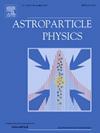Scintillation characteristics of an undoped CsI crystal at low-temperature for dark matter search
IF 2.9
3区 物理与天体物理
Q1 ASTRONOMY & ASTROPHYSICS
引用次数: 0
Abstract
The scintillation characteristics of 1 g undoped CsI crystal were studied by directly coupling two silicon photomultipliers (SiPMs) over a temperature range from room temperature to 86 K. The scintillation decay time and light output were measured using x-ray and gamma-ray peaks from a 109Cd radioactive source. An increase in decay time was observed as the temperature decreased from room temperature to 86 K, ranging from 76 ns to 605 ns. The light output also increased, reaching 26.2 ± 1.3 photoelectrons per keV electron-equivalent at 86 K. Leveraging the significantly enhanced scintillation light output of the undoped CsI crystal at low temperatures, coupling it with SiPMs results in a promising detector for rare event searches. Both cesium and iodine have an odd number of protons, making them suitable targets for probing dark matter-proton spin-dependent interactions. This study evaluates the sensitivity of the proposed detector to such interactions, incorporating the Migdal effect and assuming 200 kg of undoped CsI crystals for dark matter searches. The results indicate that undoped CsI coupled with SiPM can achieve world-competitive sensitivity for low-mass dark matter detection, particularly in the context of dark matter-proton spin-dependent interactions.
用于暗物质搜索的未掺杂CsI晶体低温闪烁特性
通过直接耦合两个硅光电倍增管,研究了1 g未掺杂CsI晶体在室温至86 K温度范围内的闪烁特性。利用109Cd放射源的x射线和伽马射线峰测量了闪烁衰减时间和光输出。当温度从室温降低到86 K时,衰减时间从76 ns到605 ns不等。光输出也增加,在86 K时达到每keV电子当量26.2±1.3个光电子。利用未掺杂的CsI晶体在低温下显著增强的闪烁光输出,将其与SiPMs相结合,形成了一种有希望用于罕见事件搜索的探测器。铯和碘都有奇数个质子,这使它们成为探测暗物质-质子自旋依赖相互作用的合适目标。本研究评估了所提出的探测器对这种相互作用的灵敏度,结合了米格达尔效应,并假设200公斤未掺杂的CsI晶体用于暗物质搜索。结果表明,未掺杂的CsI与SiPM耦合可以在低质量暗物质探测中达到世界竞争的灵敏度,特别是在暗物质-质子自旋依赖相互作用的背景下。
本文章由计算机程序翻译,如有差异,请以英文原文为准。
求助全文
约1分钟内获得全文
求助全文
来源期刊

Astroparticle Physics
地学天文-天文与天体物理
CiteScore
8.00
自引率
2.90%
发文量
41
审稿时长
79 days
期刊介绍:
Astroparticle Physics publishes experimental and theoretical research papers in the interacting fields of Cosmic Ray Physics, Astronomy and Astrophysics, Cosmology and Particle Physics focusing on new developments in the following areas: High-energy cosmic-ray physics and astrophysics; Particle cosmology; Particle astrophysics; Related astrophysics: supernova, AGN, cosmic abundances, dark matter etc.; Gravitational waves; High-energy, VHE and UHE gamma-ray astronomy; High- and low-energy neutrino astronomy; Instrumentation and detector developments related to the above-mentioned fields.
 求助内容:
求助内容: 应助结果提醒方式:
应助结果提醒方式:


